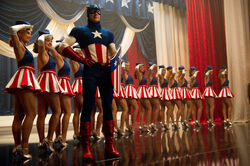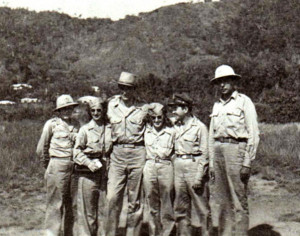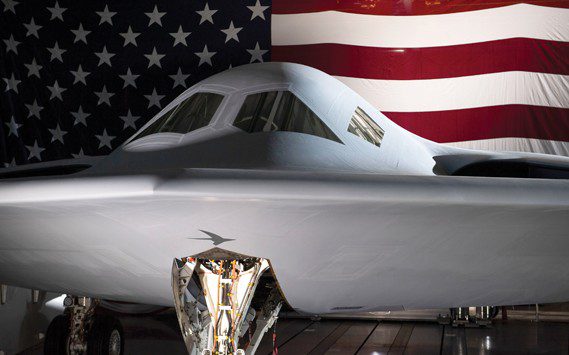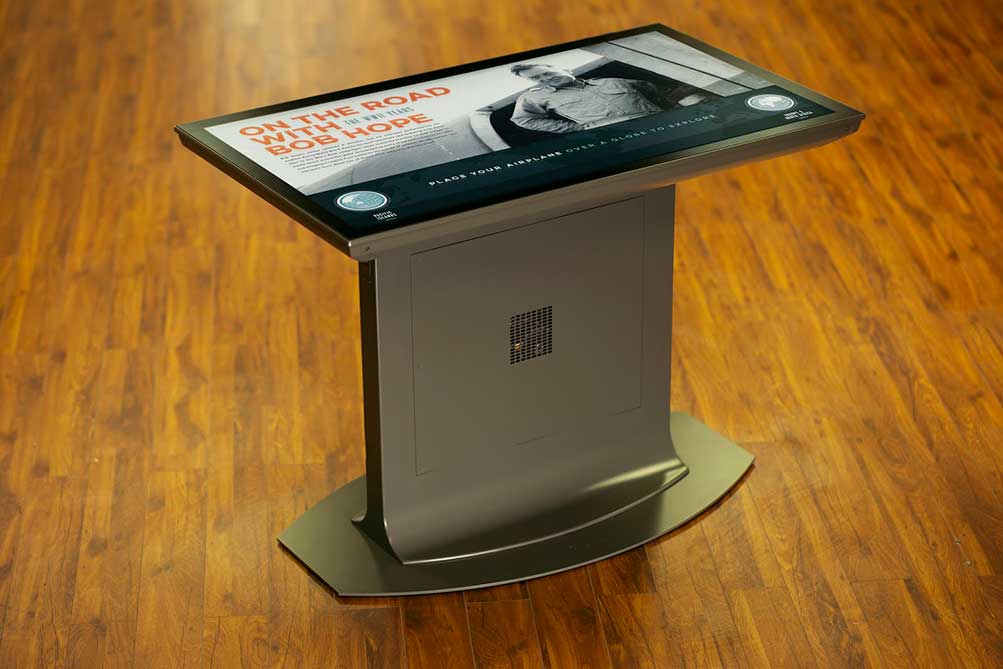Marvel Cinematic Universe Wiki
The recent release of the book "Marvel Studios' The Marvel Cinematic Universe: An Official Timeline" requires a lot of analysis. Members of WikiProject:Timeline team are working on editing pages in response to the information revealed in the book. If you wish to contribute, please do not immediately edit these pages, and instead visit the Timeline Discussion.


Captain America's USO Show
- View history
Captain America's USO Shows were a series of live-entertainment performances made by Steve Rogers , assuming the identity of " Captain America ", as a public symbol of the United States of America during World War II .
- 3 Behind the Scenes
- 4 References
History [ ]
Steve Rogers was chosen to embody the role of the American spirit during World War II due to his heroic victory over the HYDRA spy, Heinz Kruger . The event made the front page in many newspapers, and Senator Brandt realized he had potential as a public symbol and propaganda figure to boost the morale of the nation by promoting the purchase of war bonds.
Rogers joined the USO and began touring the nation in a colorful costume as " Captain America ", accompanied by a chorus named the Star Spangled Singers , who dance and playfully gushed in the presence of the Captain. The shows were fully orchestrated and a band of marching drummers would also join the stage. The big finale featured confetti cannons and Cap lifting a motorcycle ridden by showgirls.

Captain America and the Star Spangled Singers
Rogers' shows included a speech about the importance of the common citizen during the war, a dancing show by the Star Spangled Singers, feats showing Rogers' strength, and a climatic moment when Captain America punched another actor portraying Adolf Hitler .
Rogers' success during these shows led to comics and movies about "Captain America"'s adventures during World War II, [1] trading cards , [2] and even a radio series entitled The Captain America Adventure Program . [3] Rogers even lost his virginity to a woman during the tour. [4] When Rogers took the tour to soldiers on the front lines however, he was openly mocked and the soldiers demanded the dancers to come back.
The tour ended when Rogers saved the lives of nearly 400 imprisoned soldiers and finally entered the war like he had always dreamed and intended. [1]
- By the time Steve Rogers joined World War II by rescuing a group of prisoners of war in Austria , he had knocked " Adolf Hitler " over 200 times, indicating that he has done over 200 shows.
- In his speeches, Captain Rogers would encourage the purchase of "Series E Defense Bonds." This is incorrect for the time period, as they were only called Defense Bonds until 1942. From 1942 to 1945, they were known as "Series E War Bonds".
Behind the Scenes [ ]
- The uniform that Steve Rogers wore during his performances is a copy of the first uniform he wore in the original comics, while the scene where he punches an actor portraying Adolf Hitler is based on the cover of the first issue of Captain America Comics .
- The Captain America's USO Show was a way to reference the title character's first comic book cover, in which Captain America punches Adolf Hitler . As producer Kevin Feige and his creative team couldn't find any logical scenario to have Rogers punch the actual Hitler in the movie, they resolved to have him punch the dictator in a USO Show's sequence. It was director Joe Johnston 's favorite sequence in the movie. [5]
References [ ]
- ↑ 1.0 1.1 Captain America: The First Avenger
- ↑ The Avengers
- ↑ Agent Carter: 1.02: Bridge and Tunnel
- ↑ She-Hulk: Attorney at Law: 1.01: A Normal Amount of Rage
- ↑ The real reason Captain America doesn't punch Hitler in his new movie
- 1 Deadpool & Wolverine
- 3 Phase Five

- Browse Collections
- Teaching Guides
USO Show with Bob Hope, 1944
Return to military service, description, contributor.

- ← Previous Item
- Next Item →

Bob Hope’s USO
Bob Hope headlined 57 USO tours, bringing laughter to the lives of U.S. military men and women.
Comedian Bob Hope (1903 – 2003) was one of the best known, most loved, and longest lasting stars in the entertainment business. For six decades, Hope made us laugh in movies, on television, and in print. He was renowned for his longevity (he was 100 years old at the time of his death), his love for golf, and his contributions to charity. But perhaps Hope’s greatest legacy is his work entertaining the troops.
Beginning in 1941 and continuing for half a century, Hope headlined 57 USO tours, bringing laughter to the lives of U.S. military men and women serving in World War II , Korea , Vietnam , the first Gulf War, and beyond. And he was deeply proud of this work. When President Bill Clinton named Hope an honorary veteran in 1997, Hope responded, “I’ve been given many awards in my lifetime — but to be numbered among the men and women I admire most — is the greatest honor I have ever received.”
As we pay tribute to veterans , we take a look at a few highlights of the honorary veteran’s work for the USO.
1944: A World War II show presented “somewhere in the South Pacific”
1957: In Guam and Japan with Jayne Mansfield
1966: Entertaining the troops in Cu Chi, Vietnam on Christmas Day
1984: Christmas in Beirut
1990: One of his final USO tours, with Rosemary Clooney
Legacy Staff
Legacy produces award-winning original content ranging from national news obituaries to features and FAQs on a wide variety of life-and-death topics.
More Stories
O.j. simpson (1947–2024), nfl star, defendant in trial..., ralph puckett jr. (1926–2024), last korean war medal..., cole brings plenty (1996–2024), actor in yellowstone prequel....
- Advertising
- PDF Edition
- Distribution
- Business Directory
- On This Date
- Photo Archive
- Space/Technology
- Digital Edition
- High Desert Hangar
- Special Issue

High Desert Hangar Stories: John Wayne’s contributions to the war effort

By Bob Alvis, special to Aerotech News
This Veterans Day, I was thinking of all those who never served, but embodied that same wartime spirit of the American fighting man.
I don’t think anybody would doubt that John Wayne was an advocate for the military in this country, but a few kind of took exception to The Duke’s non-military service in World War II. I would like to say a few things to help give context to the role Wayne played during World War II.
Marion Morrison was born in Iowa on May 29, 1907. The family came to southern California soon after and, due to his dad’s health conditions, they moved up here to the Antelope Valley. They farmed a small ranch near the present day UPS facility on Avenue L and Sierra Highway. Young Marion attended Lancaster Elementary School on Cedar Street, riding an old horse back and forth to classes on dirt trails south of Lancaster. The family was only here for a short while, as the farming did not take hold, and they soon found themselves living in Glendale. Eventually Marion learned the trade of acting and transformed into the mighty Duke — the John Wayne of movie fame.
Having established himself as an actor and a fan favorite, he was in high demand. When Dec. 7, 1941 came around, that demand went even higher.
It is said that wars are not just won by bombs and bullets, but by hearts. With brave service members risking their lives in battle, it’s the job of those on the home front to provide endless encouragement to their protectors overseas. Americans have always honored and encouraged their troops and World War II was no different.
President Franklin Roosevelt was determined military service members would be honored for their sacrifices by a strong support system, both at home and on the front lines. From that desire, Roosevelt requested a morale boosting service be created to provide recreational activities and entertainment for the tenacious American Soldiers.
Mary Ingraham, then president of the YWCA, became the head person that would bring many service groups together to form the United Service Organization — “USO”. That organization was tasked to provide recreation, but they also wanted to be a reflection of America. From that desire, the famous Camp Shows became the hallmark of the USO. For the entirety of the war, they would present more than 400,000 shows at bases and on ships all over the world. Mary was faced with creating an Army of her own that would be the face of America. She was given permission to draft entertainers who would bring a bit of home to the soldiers in the field. Her first class of inductees included Bob Hope, Fred Astaire, Rita Hayworth, Frank Sinatra and John Wayne. The tour performers made it their mission to alleviate all kinds of suffering, but none more than homesickness.
Nobody better represented American values, culture and the comforting feeling of home then John Wayne. The actor was determined to do his part and provide his support for the brave men overseas in any way he could. During his first overseas USO tour in 1943, Duke performed twice a day for three months straight, visiting south west Pacific bases and front lines across Australia, New Britain and New Guinea. John Wayne did what he did best, even in a world away from home. He represented the heart of America by showing an unwavering appreciation to those sacrificing their lives. Moved by the troops’ dedication, Duke tried to match their endurance. Not only did he perform twice a day, but he also visited hospitals, sat with injured troops and swapped stories deep onto the night.
Upon returning home, John Wayne reflected during a press conference on what he tried to provide to the soldiers during his travels. “They’re where 130 degrees is a cool day; where they constantly scrape flies off; where matches melt in their pockets and daisy cutter bombs take legs off at the hip. They will build stages out of old crates then sit in the mud and rain for three hours just to hear somebody say “Hello, Joe.”
John Wayne formed deep bonds with service members on tour and even after returning to Hollywood he continued to be their link to America by writing letters to them. The Camp Shows evolved into a welcome, sentimental reminder of American life for the troops. If those familiar to them — friends, family and loved ones — were unable to visit the war zones, figures like John Wayne were the next best thing to evoke warm memories and comforting feelings of home. John Wayne never put on the uniform of this country except for a movie role, but The Duke did serve in a capacity that was just as important to every service man that stood a post or faced a battle: he gave them a bit of home and a reason to press on.
On this Veterans Day, we salute and remember our veterans. We must also be thankful for those who served in a different manner by taking on the role of a mother or father, sister or brother, taking the minds of those far from home off the horrors of war and giving them hope. Until next time, Bob out ….
More Stories

Contract Briefs

Headlines — April 12

The B-21 Raider get amazing...

Unsung heroes secure X-37B Orbital...

- Aerotech News: Antelope Valley
- Aerotech News: Edwards AFB
- High Desert Warrior: Ft. Irwin NTC
- Desert Lightning News: Nellis/Creech AFB
- Thunderbolt: Luke AFB
- Desert Lightning News: Davis-Monthan AFB

Aerotech News and Review , published every other Friday, serves the aerospace and defense industry of Southern California, Nevada and Arizona.
News and ad copy deadline is noon on the Tuesday prior to publication. The publisher assumes no responsibility for error in ads other than space used.

- Our Products
- Work With Us
The New York Public Library
Archives & manuscripts, camp shows publicity records 1941-1955 d.
- Toggle Mini Map
- View as Network
- Collection Overview
Biographical/historical information
Scope and arrangement, administrative information, using the collection.
USO Camp Show Publicity Records, *T-Mss 1991-007, Billy Rose Theatre Division. The New York Public Library for the Performing Arts.
The USO Camp Show Records document, through photographs, the tours to American serviceman of performing artists from World War II up to and including the Korean War.
The USO (United Service Organizations, Inc.) was formed in 1941, its purpose being "to aid in the war and defense program of the United States and its Allies by serving the religious, spiritual, welfare, and educational needs of the men and women in the armed forces and the war and defense industries..., and in general, to contribute to the maintenance of morale in American communities and elsewhere." (USO Constitution and By-Laws)
During its initial years of operation (1941-1947) the Camp Shows brought entertainment to United States and Allied service men overseas, at home, in hospitals, and in occupied territories. Theater productions as well as entertainment featuring Hollywood personalities and novelty performers entertained servicemen all over the world.
The USO Camp Show Publicity Records consist of reports, clippings, posters and photographs for the years 1941 through 1955.
The records deal solely with the USO entertainment effort during World War II and Korea, as well as the USO entertainment effort in the veterans' hospitals during and after the war.
The Camp Shows Publicity Records are arranged in three series:
The History of the U.S.O. series contains working notes and an annotated manuscript by Clayton Hamilton dealing with the origins and progress of U.S.O. during World War II.
The Reports and Office Files of the U.S.O. Camp Shows Publicity Records encompass the years 1941 through 1952. The reports include statistics, names of troupes, locations and newsclippings and articles concerning the activities of the various groups. The office files are primarily promotional in scope and include, memos, press releases, clippings, flyers and a small amount of correspondence. There are also copies of 3 speeches given in 1945 by Clayton Hamilton on the topic of the U.S.O.
The photographs files of the U.S.O. Camp Shows Publicity Records are arranged in 4 sub-series. The first sub-series is arranged alphabetically by performer and include most of the famous stars which were involved in the U.S.O. tours during World War II. The second sub-series is arranged by O.S.U. (organizational service unit) and are listed in chronological order by number. The third sub-series is by subject and contains Christmas shows, hospital entertainment and assorted other categories. The last sub-series contains two boxes of miscellaneous negatives arranged alphabetically by subject. Other negatives can also be found in individual folders under performer or by troupe number.
Custodial history
This collection was a gift from Camp Shows, Inc. in 1958. The records had been in the custody of historian Clayton Hamilton until his death, when they were returned to Camp Shows by his widow.
Source of acquisition
Processing information.
Processed by Mary Ellen Rogan; machine-readable finding aid created by Mary Ellen Rogan.
The U.S.O. Camp Shows Publicity Records were donated to the Billy Rose Theatre Division prior to 1980. It was in good condition and needed no conservation treatment at the time of archival processing. Posters were separated and filed separately. Arrangement and description was completed in 1991.
Separated material
- 6 - set and prop designs by Paul Morrison
- 3 - prop designs and set elevations by Edward Gilbert
- 10 - set and prop designs by Ralph Alswang
- 4 - unidentified set designs
Posters have been removed and cataloged separately
Access to materials
Conditions governing use.
For permission to publish, contact the Curator, Billy Rose Theatre Division.
Access restrictions
Photocopying prohibited.
Container List
Alphabetical
Chronological and Alphabetical
- Privacy Policy
- Rules and Regulations
- Using the Internet
- Website Terms and Conditions
- Gifts of Materials to NYPL

WWII Museum Visitors Experience Bob Hope’s Wartime USO Tours
National world war ii museum, new orleans, la, tangible engine, multitouch table, software development.
Bob Hope was a 20th-century entertainment giant known for decades of appearances in vaudeville, films, and television. But perhaps his most important and enduring work occurred overseas: For fifty years, Hope traveled to army bases, airfields, military hospitals, and war zones as part of tours organized by the United Service Organizations , popularly known as the USO. His shows brought much-needed laughter and a glimpse of home to thousands of soldiers around the globe.
Ideum was very proud to work with the National World War II Museum in New Orleans to develop a new exhibit that lets visitors explore the depth and impact of Hope’s contribution to military morale in WWII. On the Road with Bob Hope focuses on Hope’s 1943 tour of Europe and Africa and 1944 tour of the South Pacific. The exhibit is part of a larger exhibition, So Ready for Laughter, which opened at the Museum in May.
Visitors start their journeys by selecting a tour with a custom tangible object containing a model of a WWII-era C-47 transport plane. (Docents can also set the experience to run in a non-tangible touch mode.) They then zoom from a global to a regional view and select individual dates and locations to investigate. At each location, users can see images and videos of historical performances and view high-resolution photographs of original itineraries, letters, and other artifacts. The exhibit runs on an Ideum 49” Presenter touch table with a custom gray powdercoat finish.
Hope and his “Gypsies” sometimes gave numerous shows in a single day, and often performed dangerously close to the fighting—but they were undeterred by air raids, plane crashes, or fatigue. They often remarked on how much it meant to them to provide smiles and solace to allied fighting men and women. Hope’s support of our military didn’t end with World War II; he and a changing cast of comedic and musical comrades toured military bases during the Korean and Vietnam Wars and continued their journeys to support soldiers in conflicts in the Middle East into the 1990s.
In 1997, an Act of Congress named Hope an Honorary Veteran. He remarked that “I’ve been given many awards in my lifetime, but to be numbered among the men and women I admire most is the greatest honor I have ever received.”
So Ready for Laughter will be open to the public at the World War II Museum until February 2019. The On the Road touch table exhibit will remain part of the Museum’s permanent collection.

Related Projects

National WWII Museum Explores the History and Impact of Andrew Jackson Higgins

Digital Memorial Explores the Stories of Korean War Veterans

- Special Collections
- Modern Songs of War and Conflict
- Sheet Music
- Visual Narratives
- Sonic Narratives
- Further Research
- Bibliography
- Finding Aid
- Special Collections in Performing Arts
The United Service Organizations (USO)

The Second World War saw dramatic increases from the first in the number of voluntary enlistments (6 million up from 2) and in draftees ( 11.5 million up from 2.8). As with the first World War, most of these newly enlisted were in their teens and twenties when headed to the frontlines of the war. At The behest of President Franklin D. Roosevelt, the United Service Organizations were established in 1941 to boost morale among service members while abroad and on leave. An amalgam of a number of religious and public institutions, the USO quickly went to work raising private funds to establish centers throughout the U.S. and abroad. These centers generally offered recreational activities like music and film screenings as well as its early hallmark, coffe and donuts.
As the USO became more well established, the organization became synonymous with its Camp Shows , live staged variety acts including some of the most well known stars of film, radio, and music. During the years of U.S. involvement in WWII the U.S.O. put on over a quarter of a million performances in the United States and abroad, and became significant mediators of popular culture to enlistees and their families. Likewise, the U.S.O. was the largest institution through which popular entertainers that were not enlisted became a part of the war effort. Such was the case with singer, actress, and dancer Lena Horne, pictured above autographing a photo. Having made her film debut in 1943 starring in Stormy Weather Horne toured extensively through the USO donating her time and helping to propel her career at a time when segregation in the film industry threatened her career prospects. Throughout her time with the USO Horne performed domestically and made frequent appearances on Armed Service Radio Programs introducing many to her voice and music.
Jane Frohman, pictured right singing on an Armed Forces Network broadcast in 1943, had a similarly prolific tour with the USO albeit after she had become a well-established figure in popular music. Frohman rose to prominence after being featured in the 1933 renewal of the famed Ziegfield Follies Broadway review and by 1934 was one of the most popular singers in the country. Frohman performed extensively in Europe through the USO, although her life was almost claimed by a deadly air crash in Portugal. Even with permanately debilitating injuries, Frohman continued to tour extensively giving 95 concerts in 1945 alone.
As service members were surrounded by USO events overseas and domestically, the USO quickly became a fixture of American popular culture. During the war the USO's influence was such that the U.S. Army became concerned that the USO would dissuade potential enlistees as depictions of the USO centers in films were so lush that it made military service look spartan by comparison. The popularity of the USO and its camp shows reached the point that Irving Berlin was hired to produce a feature-length musical and film about entertainment's role in the war which became This Is The Army . The hugely successful production would go on to tour internationally non-stop until after the end of the war. The USO quickly became singularly influential in shaping the relationship between popular entertainment and the military, a relationship that would continue to the present day.

Photo Credits
Schomburg Center for Research in Black Culture, Photographs and Prints Division, The New York Public Library. "Lena Horne, African American actress, singer, and sponsor of the SS George Washington Carver, signing autographs for African American shipyard workers who helped build the ship, on the day of its launching, Richmond Shipyard No. 1" New York Public Library Digital Collections.
Billy Rose Theatre Division, The New York Public Library. "Jane Frohman in uniform facing microphone." New York Public Library Digital Collections.
Sources Cited
Andrews, Maxine (Maxene), and Bill Gilbert. Over Here, Over There: The Andrews Sisters and the USO Stars in World War II . New York: Kensington, 1993.
Feldstein, Ruth. How It Feels to Be Free: Black Women Entertainers and the Civil Rights Movement . Oxford: Oxford University Press, 2013.
Stone, Ilene. Jane Froman: Missouri’s First Lady of Song . Columbia: University of Missouri Press, 2003.
Modern Songs of War And Conflict takes a focused look at how popular music has been impacted by, responded to, and shaped American wars of the Twentieth Century. This exhibit is drawn from the Keesing Collection on Popular Music and Culture.
Funding for this project was generously provided by Hugo Keesing.
Exhibit Curator: Ben Jackson Curator for SCPA: Vincent Novara
With help from: Cindy Zhao, Alice Rogers, Meghan Creek, Hugo Keesing, and Susan Wiesner.
Special Collections in Performing Arts (SCPA) is located in the Michelle Smith Performing Arts Library on University of Maryland's College Park campus. We collect, serve, and preserve performing arts materials that document performance practice, instruction, and scholarship.
For more information about visiting SCPA and our collections, please contact us.
For more information about the Michelle Smith Performing Arts Library and our resources, please visit our website.
Stay Connected
Credits: Images courtesy of Art Today
- Action/Adventure
- Children's/Family
- Documentary/Reality
- Amazon Prime Video

More From Decider


'The Golden Bachelor' Stars Gerry Turner And Theresa Nist Divorcing Three...

'The View' Reacts To O.J. Simpson's Death: "The Tragedy Was The...

'The View' Forced To Evacuate Their Studio Before Wednesday's Show After...

'X-Men '97' Gives Gambit a Hero Moment You'll Never Forget

Holly Madison Says She “Tried” Exotic Dancing But Doesn’t Have...

'Captain America: The Winter Soldier' at 10: The Movie That Made (and...

Joy Behar Says She Was "Dragged Into" Controversy Over Beyoncé's 'Jolene'...

Guy Fieri Calls Drew Barrymore "Gangster" For Talking With Her "Mouth Full...
Share this:.
- Click to share on Facebook (Opens in new window)
- Click to share on Twitter (Opens in new window)
- Click to share on WhatsApp (Opens in new window)
- Click to email a link to a friend (Opens in new window)
- Click to copy URL
Which ‘Captain America’ Girl F**ked Steve Rogers: Natalie Dormer, Laura Haddock, or a USO Dancer?

Where to Stream:
- She-Hulk: Attorney at Law
'Love Lies Bleeding' Is Secretly the Best Hulk Movie So Far
'abbott elementary's showrunners knew josh segarra was the perfect manny: "we wanted someone who felt very warm, but also a little suspect", how to watch the marvel movies in order, marvel shocker: studio realizes they need to make tv shows for television.
Disney+ ‘s latest MCU series She-Hulk: Attorney At Law finally reveals a major secret about none other than the O.G. Captain America himself, Steve Rogers ( Chris Evans ). In She-Hulk ‘s series premiere, Jennifer Walters ( Tatiana Maslany ) is determined to get her cousin Bruce Banner (Mark Ruffalo) to reveal if Steve Rogers died a virgin. It’s a question that has dogged the fandom for years: did the wholesome and shy Steve Rogers get laid before he was trapped in ice for almost a century? Was “America’s Ass” ever tapped? And it’s not just fans who want to know; Natasha Romanov (Scarlett Johansson) also tried to pry some information about Steve’s sexual history in Captain America: The Winter Soldier.
While Bruce Banner does his best to keep his buddy’s romantic history on lockdown, in the mid-credits scene for She-Hulk “Episode 1 “A Normal Amount of Rage,” Jennifer sneaks the truth out of him. She pretends to be drunk and distraught over the fact that a hero like Captain America could have died a virgin. Hulk can’t take it anymore and says, “Steve Rogers is not a virgin. He lost his virginity to a girl in 1943 on the USO tour.”
Not only is this huge, but it’s MCU canon. In a recent Variety interview , She-Hulk showrunner Jessica Gao said, “not only was Kevin [Feige] on board with answering the question…he supplied me with the canon answer.” Marvel Studios head Kevin Feige has officially confirmed that Steve Rogers has f*cked! Even Chris Evans reacted to the news that Steve banged a broad in 1943, by tweeting three laughing emojis followed by one with the mouth zipped up.
😂😂😂🤐 #SheHulk — Chris Evans (@ChrisEvans) August 18, 2022
However the revelation in She-Hulk that Steve Rogers lost his virginity to a girl in 1943 on the USO tour begs another question: whom did Captain America lose his virginity to? Can we find the woman who served her country in this extraordinary way in the 1940s set MCU film Captain America: The First Avenger ? And is the woman in question none other than Natalie Dormer’s flirtatious, horny lieutenant?
Whom did Captain America f*ck in 1943? Well, it seems there are three possibilities, and none of them are Peggy Carter (Hayley Atwell)*.
* You know, because Peggy was in Europe fighting the war while Steve was shilling war bonds in America with the USO.
Did Natalie Dormer's Lt. Lorraine F*ck Captain America?

When you think of girls Steve Rogers kissed in Captain America: The First Avenger who aren’t Peggy Carter, Natalie Dormer’s Lt. Lorraine is the person who immediately springs to mind. After Steve bravely saves Bucky (Sebastian Stan) and the rest of the soldiers captured by HYDRA, he is feted as a hero. No one goes harder in their thanks than Lt. Lorraine. She sees Steve and immediately corners him behind a shelf to make out with him. Hard. Peggy sees this, which causes a rift between the two soulmates.
Dormer’s splashy MCU cameo came during the limbo between her work as Anne Boleyn on The Tudors and playing Margaery Tyrell on Game of Thrones. She immediately popped, though, as her character seems to give Steve his first canonical kiss.
However now that we know that Steve got laid during the USO tour in 1943, we know that’s not true. He had been kissed. And more. Just offscreen.
Natalie Dormer does not play the woman who boned Captain America for the first time. We know this because she meets him in Europe after he leaves the USO. Hence, it is not her. It was someone he would have met earlier on that fateful USO tour…
Did Steve Rogers Hook Up With a USO Dancer?

When you hear that Steve Rogers specifically lost his virginity to a girl in 1943 on the USO tour, the obvious conclusion is that he must have hooked up with one of the many dancers he was touring with. After all, night after night, he was performing, traveling, and hanging out backstage with a bevy of beauties. It’s worth noting that most of the eligible bachelors at this time would be overseas fighting, so these ladies might have been especially “hornt up” backstage and Steve would be the obvious object of their attentions.
However there are two issues with this. One, it’s not really fun or compelling to think of Cap’s first time with one of the literally nameless girls in the chorus. These women are wholly interchangeable and are never seen interacting with Steve offstage. Two, are we positive that Bruce confirmed the girl in question was a USO dancer?
Consider the sentence structure at hand. Bruce says Steve lost his virginity to a girl in 1943 on the USO tour not Steve lost his virginity to a girl on the USO tour in 1943. “On the USO tour” is used to describe the time period Steve’s wangfest happened, not the woman in question.
So, yes, it could have been one of the nameless beauties on the USO tour, but Captain America: The First Avenger gives us one fleeting glimpse of a romantic encounter Steve had canonically at this time… with “Autograph Seeker.”
Did Steve Rogers Lose His V-Card to Star-Lord's Mom?

In the middle of the Captain America USO montage, Steve meets a beautiful blonde asking for an autograph and she briefly takes his breath away. It’s a tiny beat within the larger story of Cap’s time as a star-spangled government fundraiser, but it’s clearly important for some reason! Now that we know he lost his virginity at this time, this moment feels bigger. Is this the moment of Steve’s sexual awakening?
I’m inclined to think if there’s one girl we can safely assume is the one Steve lost his V-card to, it’s the single woman he has any romantic spark with during the Captain America: The First Avenger USO montage. The sexily named “Autograph Seeker.”
Fun fact: the role of “Autograph Seeker” was played by Laura Haddock. She would be cast again in the MCU as Meredith Quinn, Star-Lord’s (Chris Pratt) mother. This isn’t the first time the MCU has double-cast actors in two separate roles. Alfre Woodward played different characters in Luke Cage and Captain America: Civil War and Gemma Chan appeared in both Captain Marvel and The Eternals. However, it is funny to think that Captain America hooked up with Star-Lord’s mom. The MCU is smaller than we think!
So, barring the revelation that it was some random USO dancer, let’s just say this pretty all-American girl got more than just a signature from Steve Rogers.
- Captain America: The First Avenger
- Chris Evans

Does 'Yellowstone' Return Tonight? Everything To Know About 'Yellowstone's Season 5, Part 2 Premiere Date

Is 'Civil War' Streaming on Netflix or HBO Max?

'The View' Reacts To O.J. Simpson's Death: "The Tragedy Was The Injustice"

Stream It Or Skip It: 'Anthracite' On Netflix, About Four People Trying To Solve A Ritualistic Murder In The French Alps

New Movies on Streaming: 'Kung Fu Panda 4,' 'Sleeping Dogs' + More

New Shows & Movies To Watch This Weekend: 'Fallout' on Prime Video + More
- 70° Sunny

- Saved Items
- MANAGE ACCOUNT
Eddie Bracken and Shirley Gallagher take the stage in the summer of 1945.
- Copy article link
Shirley Gallagher (second from right), another USO performer and wounded WWII soldiers crowd around a radio where they learn the war with Japan is over.
Shirley Gallagher lives part time in Green Valley with her husband, Bill.
1945 USO show: She rememberrs it like it was yesterday
- By Ellen Sussman Special to the Green Valley News
- Mar 17, 2013
- Mar 17, 2013 Updated Apr 3, 2013
When Shirley Gallagher looks back on her life, two months stand out — July and August 1945.
That’s when she and six other entertainers toured the South Pacific with the USO playing for the troops in the final months of World War II.
Gallagher, 90, was an accordionist living in Southern California. One of her agents — she had three — mentioned to the Hollywood Victory Committee that she might be interested in going on tour with the United Service Organization.
Her self-published book, “A Never-To-Be-Forgotten Adventure,” explains her close-to-the-heart reason for wanting to join.
“When the war struck close to home with the news of a relative reported missing in action over Germany, I realized that millions of our men faced the same fate every day. The great sacrifices they were forced to make convinced me that I had a deep obligation to participate in any way I could,” she wrote.
Her cousin, listed as missing-in-action, eventually was found alive.
Eddie or Bob?
Bob Hope and Eddie Bracken would soon be going on tour. She met Bracken and his co-star Peggy Ryan and immediately knew they were the ones she wanted to travel and entertain with.
In addition to Bracken and Ryan, four other entertainers were part of the tour — singer Maxine Conrad, dancer Roberta Stevenson and comic duo Gil Gilbert and Virginia Lee.
Gallagher went through the process of official documents, fingerprints, physicals and shots, and learned that her tour would be the first sponsored by the Navy — and that meant stricter rules than Army USO tours.
Most previous tours featuring Hollywood entertainers focused on suggestive and dirty jokes, believing that was the entertainment troops wanted and enjoyed, she said.
“But the Navy felt differently, and specifically mandated that the quality of our show be the very highest form of clean entertainment, completely void of even the slightest suggestive jokes,” she wrote.
Gallagher and those touring with her fully agreed. She said the boys appreciated their clean shows. Their USO group toured several islands in the Marianas — Saipan, Tinian and Guam, Ulithi in the Western Caroline Islands and Peleliu in the Palau chain visiting bases, hospitals and aircraft.
Gallagher said the show was always the same; she opened with “Wall Street Rag,” “Alabama Bound” and “St. Louis Blues.”
“I never got tired of playing the same songs. The men were so appreciative and always clapped for an encore.”
While entertaining on an aircraft carrier, she recalled sailors’ reactions to lack of seeing women.
“Are you real?” one called out.
“A girl, way out in the middle of the Pacific Ocean,” another bellowed on a destroyer.
Gallagher, who has lived in Green Valley part time for four years with husband, Bill, recalled extreme heat in one hospital kitchen while serving the troops.
“It was so hot but such a treat to the boys as we served them,” she recalled.
They even came across another star, of sorts. The entertainers met naval aviator and polar explorer Rear Admiral Richard Byrd.
Then there was the time when the intense heat, daily rain and humidity caused trauma for her accordion.
She was on an aircraft carrier when several reeds stopped working. A Mr. Fixit came to the rescue and discovered the heat and humidity had melted the beeswax that held the reeds in place.
He nailed them securely and the show went on.
Scary encounter
Still vivid in her mind was a frightening incident on the island of Peleliu when heavy rains came through openings in a Quonset hut and all the mattresses were soaked. They turned them over and slept in raincoats. That’s when Gallagher noticed a Japanese man with a long beard and mustache staring at her from outside.
“I screamed, and the others came running. We tried to summon a guard but he was too far away to hear us,” she said.
The man was never tracked down, and after that beds were pushed close together with two to a mattress for security, and guards were placed closer to their accommodations.
Gallagher toured with the group until World War II ended, and kept in touch with Bracken until he died in 2002, at age 87.
“We all got along so well. It was the most wonderful experience,” she said.
Gallagher still has an accordion, but it’s not the one she used on tour — that one became a casualty of war.
Contact Green Valley freelance reporter Ellen Sussman at [email protected] .
Better than a comments section
Submit your news.
We're always interested in hearing about news in our community. Let us know what's going on!
Subscription Services
Subscription services - active digital access, subscribe, missing newspaper, stop/starts etc.
- Notifications
Get up-to-the-minute news sent straight to your device.
Top Stories
Sorry , an error occurred.
Account processing issue - the email address may already exist
Receive the digital, interactive PDF of the newspaper in your inbox. Delivered right as the newspaper goes to print on Thursdays and Sundays.
Receive the digital, interactive PDF of the newspaper in your inbox. Delivered right as the newspaper goes to print on Sundays.
Sign up with
You're all set!
Thank you .
Your account has been registered, and you are now logged in.
Check your email for details.
Invalid password or account does not exist
Sign in with
Reset Password
Submitting this form below will send a message to your email with a link to change your password.
Forgot Password
An email message containing instructions on how to reset your password has been sent to the email address listed on your account.
Email me a log in link
Promotional offers.
No promotional rates found.
Purchase Gift Purchase Access
Secure & Encrypted
Secure transaction. Secure transaction. Cancel anytime.
Your gift purchase was successful! Your purchase was successful, and you are now logged in.
A receipt was sent to your email.
An error occurred

IMAGES
VIDEO
COMMENTS
Hope and his band of entertainers and crew did their first extensive run of USO shows for American troops in the combat zones of North Africa and Italy in 1943. They had an incredibly close call during a tour stop in Palermo, Italy, where German bombers destroyed the docks and buildings in the area around their hotel.
Captain America's USO Shows were a series of live-entertainment performances made by Steve Rogers, assuming the identity of "Captain America", as a public symbol of the United States of America during World War II. Steve Rogers was chosen to embody the role of the American spirit during World War II due to his heroic victory over the HYDRA spy, Heinz Kruger. The event made the front page in ...
—Franklin D. Roosevelt, 1943. The entertainment industry promoted two morale-boosting initiatives that achieved phenomenal success. On April 17, 1941, the USO (United Service Organizations) was formed by six prominent social service agencies with the approval of President Roosevelt, and was dedicated "to the maintenance of morale" of ...
In December of 1948, Bob Hope and other performers traveled to Berlin, Germany, to entertain members of the armed forces participating in the Berlin Airlift. This was his first Christmas tour to entertain troops and the beginning of a Hope tradition that lasted until1990. Nine of Bob Hope's Christmas tours included Vietnam, from 1964 until 1972.
The USO also did shows in military hospitals, eventually entertaining more than 3 million wounded soldiers and sailors in 192 different hospitals. There were 702 different USO troupes that toured the world, some spending up to six months per tour. In 1943, a United States Liberty ship named the SS U.S.O. was launched. She was scrapped in 1967.
Audio Recorded live at the Stockton California Bob Hope USO show at Stockton Air Field May 23, 1943 for the Army Air Corps Cadets. "I'll Be Seeing You".. Audio Recorded live at the Stockton ...
One of the biggest supporters of the USO was Bob Hope, and in all he headlined over 60 tours with the USO, spanning countless decades from World War II to the Persian Gulf War. In all, the Bob Hope Christmas USO tour lasted over 34 years. In 1997 Bob Hope was named the nation's first honorary veteran of the United States Armed Forces for his ...
By Legacy Staff May 26, 2013. 1. Bob Hope headlined 57 USO tours, bringing laughter to the lives of U.S. military men and women. Comedian Bob Hope (1903 - 2003) was one of the best known, most ...
During his first overseas USO tour in 1943, Duke performed twice a day for three months straight, visiting south west Pacific bases and front lines across Australia, New Britain and New Guinea. John Wayne did what he did best, even in a world away from home. He represented the heart of America by showing an unwavering appreciation to those ...
Captain America fuc**/Steve Rogers lost his virginity in 1943 on the USO tour - She Hulk Scene - Starlord's grandmother - Star Spangled Man With A Plan - Cap...
The USO Camp Show Publicity Records consist of reports, clippings, posters and photographs for the years 1941 through 1955. The records deal solely with the USO entertainment effort during World War II and Korea, as well as the USO entertainment effort in the veterans' hospitals during and after the war. The Camp Shows Publicity Records are ...
On the Road with Bob Hope focuses on Hope's 1943 tour of Europe and Africa and 1944 tour of the South Pacific. The exhibit is part of a larger exhibition, So Ready for Laughter, which opened at the Museum in May. Visitors start their journeys by selecting a tour with a custom tangible object containing a model of a WWII-era C-47 transport plane.
Jane Frohman, pictured right singing on an Armed Forces Network broadcast in 1943, had a similarly prolific tour with the USO albeit after she had become a well-established figure in popular music. Frohman rose to prominence after being featured in the 1933 renewal of the famed Ziegfield Follies Broadway review and by 1934 was one of the most ...
The ever-popular Bob Hope led the USO shows, helping to boost the morale of the soldiers overseas; he performed along with Frances Langford and other stars from his radio show. Many of Hollywood's and radio's best volunteered their time and scheduled USO tours-- in 1943, these included Adolph Menjou, Burns & Allen, Robert Young, and Judy Garland.
Consider the sentence structure at hand. Bruce says Steve lost his virginity to a girl in 1943 on the USO tour not Steve lost his virginity to a girl on the USO tour in 1943. "On the USO tour ...
Bob Hope was a USO tour staple for 50 years, making his last overseas trip to entertain troops during the Gulf War. In honor of his service and commitment to the military community, the USO center at Los Angeles International Airport bears his name today. In fact, the USO worked with Congress to designate Hope as first honorary veteran of the ...
18 July 1943 Appeared with Bob Hope Other USO Show Burtonwood, UK 28 August 1943 Appeared with Bob Hope Died Jensen Beach, FL 34957, USA 11 July 2005 MIAMI -- Frances Langford, whose steamy rendition of "I'm in the Mood for Love" captivated soldiers when she was part of Bob Hope's USO tours during World War II, died Monday at the age of 92.
USO tours in WW2 were dangerous. Thirty-seven USO entertainers died during World War II. ... The "Rosie the Riveter" song first hit airwaves in 1943, but Rosie was already hard at work supporting the war efforts. In the 1940s, America's women stepped up in droves during World War II.
A look at the USO •From 1941 to 1945, 702 USO troupes did 293,738 performances on 208,178 visits, and entertained more than 161 million troops in the U.S. and abroad.